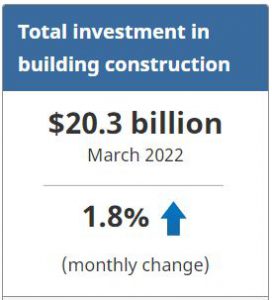Statistics Canada: Investment in Building Construction, March 2022
Investment in building construction increased by 1.8% to $20.3 billion in March. Gains were reported in both the residential (+1.7%) and the non-residential (+2.0%) sectors.
On a constant dollar basis (2012=100), investment in building construction increased 1.0% to $12.3 billion.
Single-unit construction continues to drive residential sector
Residential construction investment in March rose for a sixth consecutive month, up 1.7% to $15.1 billion. Ontario contributed about three-quarters of the monthly increase, bringing the national total to just below the record high reached in April 2021.
Investment in single family homes increased 4.3% to $8.4 billion, with Ontario (+6.2%) leading the gains.
Multi-unit construction investment decreased 1.4% to $6.7 billion in March. This ended five months of consecutive growth for the component, as declines in six provinces more than offset the strong gains reported in British Columbia (+3.8%).
Non-residential investment continues to show strength
Investment in the non-residential construction sector was up 2.0% in March compared with February, a ninth consecutive monthly increase. Quebec accounted for more than half of the gain in March.
Commercial investment gained 2.4% to $2.9 billion. All provinces reported growth, led by Quebec (+6.7%). A retail development in Mount Royal, Quebec was the largest contributor to the increase in this component.
Investment in industrial construction increased 1.9% to $910 million, with Ontario (+2.6%) and Quebec (+2.7%) contributing to the majority of the gains in March.
Institutional investment rose 1.1% to $1.4 billion in March, its third consecutive month of growth. Much of the increase in March reflected the early stages of a hospital project in Québec City.
First quarter of 2022 in review
The total value of investment in building construction increased 9.2% to $59.7 billion in the first quarter of 2022. Almost all of the first quarter’s overall gains were in the residential sector, which jumped 11.0% to $44.4 billion, while the non-residential sector rose by 4.3% to $15.3 billion.
Residential investment in the single-unit component rose 11.2% for the quarter to $24.2 billion, with Ontario (+12.6%) accounting for half of the quarterly change. The multi-unit component was up 10.9% with all provinces, except Saskatchewan, reporting growth compared with the fourth quarter of 2021.
Investment in the non-residential sector was up 4.3%, with all its sub-components increasing compared with the fourth quarter of 2021. The commercial component, which contributed the most to the non-residential sector, gained 5.1% to $8.5 billion, its fifth consecutive quarterly growth. Investments in the industrial component increased 6.1% to $2.7 billion, while the institutional component rose 1.5% to $4.1 billion.
For more information on housing, please visit the Housing statistics portal.
For the full release, click here.
Note to readers
Unadjusted data for the current reference month are subject to revision based on late responses. Data for the previous month have been revised. Seasonally adjusted data for the previous three months have also been revised.
Data presented in this release are seasonally adjusted with current dollar values unless otherwise stated. Using seasonally adjusted data allows month-to-month and quarter-to-quarter comparisons by removing the effects of seasonal variations. For information on seasonal adjustment, see Seasonally adjusted data – Frequently asked questions.
Monthly estimates in constant dollars are calculated using quarterly deflators from the Building Construction Price Index (table 18-10-0135-01). Typically, the first two months of a quarter use the previous quarter’s price level, and the data are revised when the new quarterly price index becomes available.
Detailed data on investment activity by type of building and type of work are now available in the unadjusted current dollar series.
Next release
Data on investment in building construction for April will be released on June 13.
Products
Statistics Canada has a “Housing Market Indicators” dashboard. This web application provides access to key housing market indicators for Canada, by province and by census metropolitan area. These indicators are automatically updated with new information from monthly releases, giving users access to the latest data.
Source: Statistics Canada


